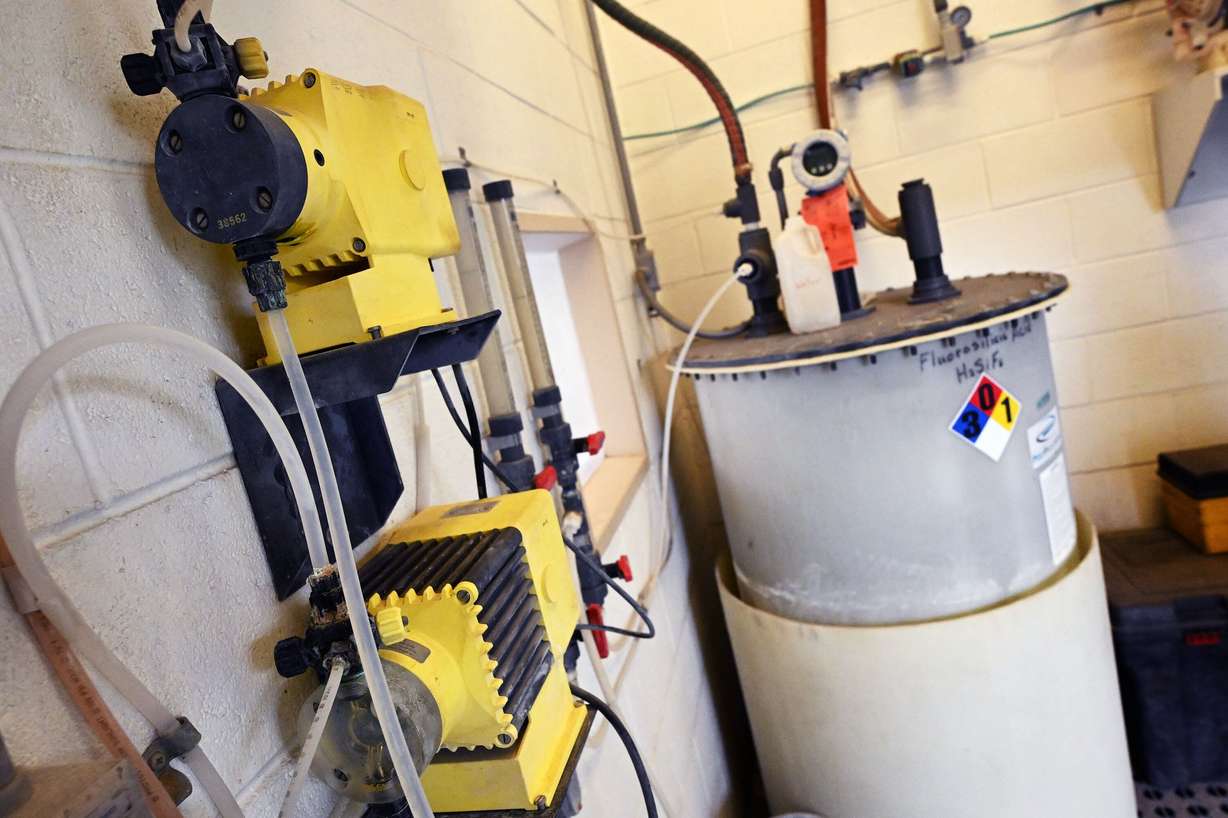Estimated read time: 8-9 minutes
- Utah bans fluoride in public water, first state to do so in U.S.
- Removal process is costly, hazardous; Weber Basin spent $6.3 million on fluoride.
- Judge's ruling on fluoride's risk to children's IQ influenced Utah's legislative decision.
SALT LAKE CITY — Utah public water systems that fluoridate their water are now facing a tricky path forward of slowly removing the chemical and ways to safely dispose of what remains at existing injection wells.
It is a complicated and at times costly process to ensure systems are in compliance with the May 7 law that mandates fluoride is no longer added to public drinking water systems.
Utah became the first state in the nation when Gov. Spencer Cox signed HB81, sponsored by Rep. Stephanie Gricius, R-Eagle Mountain, to prohibit the addition of fluoride to public drinking water systems. Other states — including Nebraska, Florida and Arkansas — are also looking at removing the substance. Hawaii has never added fluoride to drinking water.
Gricius accomplished the seemingly impossible despite the tremendous opposition to her measure by the American Dental Association and other medical groups that launched an intense campaign urging the governor's veto of the bill.
Yet she also had an outpouring of support from consumers and parental groups who live in areas that had passed voter referendums to introduce the substance, arguing they were ingesting something due to the will of others and deserved to have autonomy over their own bodies.
Both Salt Lake and Davis counties passed these referendums in the early 2000s, and in Davis County's case by a slim majority. Both Helper and Brigham City also fluoridate their water.

At Weber Basin Water Conservancy District, the slow removal of fluoride from their system poses particular challenges because it serves non-fluoridated water users in Weber County numbering about 300,000 people and Davis County, where residents there voted to add the substance to their drinking water. That is about 400,000 people.
The line splits at the mouth of Weber Canyon, sending water north to Weber County and south to Davis County.
Operationally, it was a nightmare of sorts for the district's deputy general manager, Darren Hess, who testified in committee hearings about dealing with highly variable flow rates in delivery systems and making sure the 10 injection wells were properly functioning so the fluoride went where it was supposed to.
Since the inception of the fluoride program, general manager Scott Paxman said the district has spent just over $6.3 million.
"This chemical is probably the most potent chemical that we deal with in water treatment. It's got a pH of about 2. Our Weber basin operators have 10 fluoride buildings that they're going into every day, and we're seeing our operators suffering from serious migraines, respiratory issues because of the off gasses from that hydrofluoricidic acid. So it's not only the health and safety of those that are drinking the water that we're concerned about, but also that of our operators as well, which is a big concern of ours," he said.
Hydrofluorosilicic acid is a waste product from phosphate mining operations that is a hazardous, poisonous material containing lead and arsenic. It has to go through a rigorous dilution process.
Paxman said one well station that had not been used still contained some of the leftover material. The district contracted with Clean Harbors, a hazardous waste company with 45 years of experience, to remove 600 gallons of the material at a cost of $12,000.
"I thought to myself, 'Wow, this is not going to be cheap.'"

Overall, he suspects the district will spend upward of $150,000 to remove the hazardous waste from its injection wells and then will have to go about decommissioning those injection sites.
The district has already lowered its feed level to .05 parts per million and is following guidance issued by the Utah Department of Environmental Quality on best practices.
"Water systems should work with local health authorities when adjust fluoride levels to ensure compliance and avoid issues of adding too much or too little fluoride," a state memo on the issue says.
Water systems must fully disconnect all fluoridation equipment, such as dosing pumps and chemical storage tanks, by May 7 and submit photo evidence of the disconnection to the agency by no later than June 6. The remaining chemicals must be disposed of in coordination with the Division of Waste Management and Radiation Control, which will ultimately oversee the disposal of hazardous waste at appropriate sites.
"Since this is a hazardous chemical, with elevated levels of arsenic, lead, mercury and chromium, it must be handled and disposed of as a hazardous chemical, as state and federal regulations require," Paxman said in an email to some of his colleagues.
Stevie Norcross, assistant director of the state Division of Waste Management and Radioactive Control, said disposal sites run by Clean Harbors and Aaragonite are licensed to handle such waste, which must be properly sealed in a container for safe disposal.
After May 7, Paxman said the systems will be "mothballed," power disconnected, water connection shut off, and they will be winterized.
"It's very acidic. So even the fumes just start attacking anything metal in the room, including electronics, and it even makes plastics brittle. So we were always replacing pumps, replacing doors, replacing piping, because it is such a corrosive thing. And then if you ever got it on your skin, we have to have safety showers in each of those buildings because they just have to get it washed off immediately," Paxman said. "We've heard nightmares from other operators. ... Just handling the product has been a big pain."
Both Weber and Davis counties came out in support of the removal of the product, and Riverton's City Council urged support of getting it out of the drinking water system.
J.D. Mortensen, chairman of the board of trustees for the South Davis Water District, said the entire board voted to have it removed as well.
"The main thing was people should have a choice of what they have in their water, and we recognize that you have to put in chlorine, but chlorine is really a disinfectant, and it is clearly there to stop cholera, typhoid and other diseases, you know. But fluoride, you can get it over the counter or from a pharmacy," Mortensen said.
There were a couple of key factors that spurred the legislation and its passage in Utah.
First, in what has been described as a historic ruling, a federal district judge said last year the U.S. Environmental Protection Agency must revisit the amount of fluoride added to drinking water.
Judge Edward Chen said the maximum fluoride concentration put in drinking water posed an "unreasonable risk" to children's developing brains.
"The scientific literature in the record provides a high level of certainty that a hazard is present; fluoride is associated with reduced IQ," wrote Chen, an appointee of former Democratic President Barack Obama, according to NBC News.
But the judge in the California ruling stressed he was not concluding with certainty that fluoridated water endangered public health.
The ruling was hailed by the environmental group Food & Water Watch, which led a coalition of organizations that sued the EPA in 2017.
Locally, a Sandy overfeed of the hydrofluorsidic acid sickened hundreds of people after a snow storm caused a feeder station to malfunction.
An independent investigation by an engineering firm looking at the fluoride overfeed in Sandy revealed missteps at all levels by government agencies handling the emergency.
Those agencies include the city of Sandy, the Salt Lake County Health Department and the state division with responsibility over regulating drinking water.
Testing in some samples showed fluoride at 40 times the federal threshold.
"(The drinking water division) and the (Salt Lake County Health Department) both have requirements in relation to public notification," the report said, noting that the public notification process resulted in delaying documents to affected residents in an adequate fashion in the 2019 event.
Water districts are provided with a certificate of analysis from their provider which shows the percent of substances in the hydrofluorcidic acid.
At Weber Basin, one certificate from their provider showed fluoride at 19.5%, arsenic at 13.51 parts per million and chromium at 4.87 parts per million, prior to dilution.
Paxman and others in support of the law pointed out how easy it is for young parents to accidentally overdose their babies by mixing formula with water that has been fluoridated.
The current enforceable drinking water standard for fluoride is 4.0 milligrams per liter, according to the U.S. Environmental Protection Agency. This is the maximum amount that is allowed in water from public water systems. It is set to meet the current public health goal for protection against increased risk of crippling skeletal fluorosis, a condition characterized by pain and tenderness of the major joints.
EPA also has a non-enforceable secondary standard for fluoride of 2.0 milligrams per liter, which is recommended to protect children against the tooth discoloration and/or pitting that can be caused by excess fluoride exposures during the formative period prior to eruption of the teeth.
Fluoride can occur in drinking water naturally as a result of the geological composition of soils and bedrock, according to the agency. Fluoride is also added to some toothpastes and mouth wash, making over exposure a risk.
Dentists topically apply fluoride to teeth and then the mouth is rinsed and the substance gets spit out. The addition of the substance to drinking water systems can compound the amount a young child is receiving.
While Weber Basin spent millions to invest in the distribution system of fluoride and its maintenance and operation of the well sites, the additive became a financial albatross and an inefficient one at that for Brigham City.
"It is in my opinion it is a waste of public monies when we fluoridate an entire water system. From Brigham City's experience, we spend $100,000 to $150,000 annually to add fluoride to the drinking water. Our engineers estimate that only 5% of that water is consumed by the humans within Brigham City. That's pretty easy math," Mayor D.J. Bott testified in a committee hearing. The rest ends up on the lawn or in gardens, flushed down the toilet or in dishwashers."
"We spend $100,000 to fluoridate the water with a chance that maybe 5,000 people may consume it," he said.










